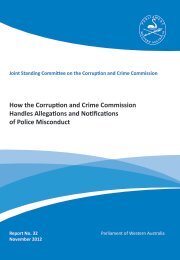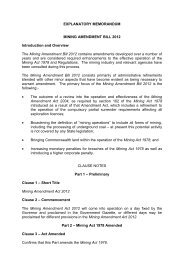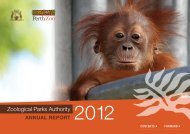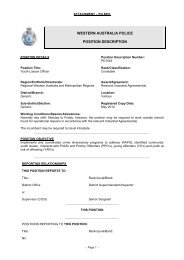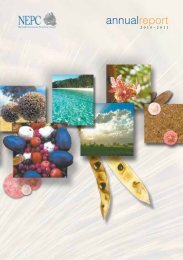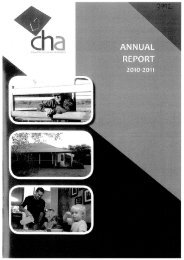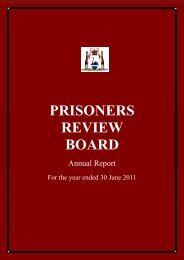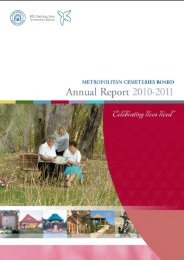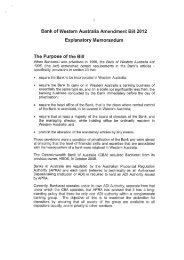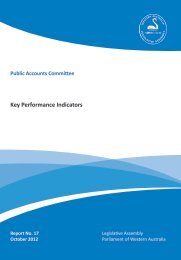Reproductive Technology Council - Parliament of Western Australia
Reproductive Technology Council - Parliament of Western Australia
Reproductive Technology Council - Parliament of Western Australia
Create successful ePaper yourself
Turn your PDF publications into a flip-book with our unique Google optimized e-Paper software.
<strong>Western</strong> <strong>Australia</strong>n<br />
<strong>Reproductive</strong> <strong>Technology</strong> <strong>Council</strong><br />
-`
This Report is available from The <strong>Reproductive</strong> <strong>Technology</strong> <strong>Council</strong> website<br />
http://www.rtc.org.au<br />
A copy may be obtained free <strong>of</strong> charge from:<br />
The Executive Officer<br />
The <strong>Western</strong> <strong>Australia</strong>n <strong>Reproductive</strong> <strong>Technology</strong> <strong>Council</strong><br />
189 Royal Street<br />
EAST PERTH WA 6004<br />
September 2011
This page has been left blank intentionally.
<strong>Reproductive</strong> <strong>Technology</strong> <strong>Council</strong><br />
Dr David Russell-Weisz<br />
A/Chief Executive Officer<br />
Department <strong>of</strong> Health<br />
189 Royal Street<br />
EAST PERTH WA 6004<br />
Dear Dr Russell-Weisz<br />
It is with pleasure that I submit the Annual Report <strong>of</strong> the <strong>Reproductive</strong> <strong>Technology</strong><br />
<strong>Council</strong> (<strong>Council</strong>) for the financial year 2010-2011. This report sets out details <strong>of</strong><br />
reproductive technology practices in this State and activities <strong>of</strong> the <strong>Council</strong>, as<br />
required by the Human <strong>Reproductive</strong> <strong>Technology</strong> Act 1991. It is in a form suitable<br />
for submission to the Minister for Health and also, as is required, to be laid by the<br />
Minister before each House <strong>of</strong> <strong>Parliament</strong>.<br />
This year <strong>Council</strong> has focused on the assessment <strong>of</strong> surrogacy applications and the<br />
development <strong>of</strong> guidelines and standards for counselling surrogacy participants. This<br />
year, <strong>Council</strong> approved the first surrogacy application under the Surrogacy Act 2008.<br />
<strong>Council</strong> recognises that some people find it very difficult to reach a decision regarding<br />
their stored embryos, and is developing an 'End <strong>of</strong> Embryo Storage' brochure to<br />
provide information on the available options.<br />
<strong>Council</strong> members have liaised with the Department <strong>of</strong> Health to inform submissions<br />
to the legislative review <strong>of</strong> the Prohibition <strong>of</strong> Human Cloning Act 2002 and Research<br />
Involving Human Embryos Act 2002.<br />
<strong>Council</strong> members have also liaised with the Department <strong>of</strong> Health to inform<br />
submissions to the Senate inquiry into donor conception practices in <strong>Australia</strong>.<br />
In addition, the <strong>Reproductive</strong> <strong>Technology</strong> <strong>Council</strong> Counselling Committee continues<br />
to build expertise in facilitating contact between participants <strong>of</strong> donor conception,<br />
which has informed policy development and pr<strong>of</strong>essional education.<br />
It is not possible for <strong>Council</strong> to operate effectively without the significant support <strong>of</strong> a<br />
number <strong>of</strong> people who provide their expertise and time to attend to matters requiring<br />
<strong>Council</strong> consideration. I especially wish to thank <strong>Council</strong> and Committee members<br />
for their ongoing commitment. Finally, I recognise the ongoing financial contribution<br />
by the Department <strong>of</strong> Health, the support <strong>of</strong> Legal and Legislative Services, and the<br />
administrative support provided by staff <strong>of</strong> the <strong>Reproductive</strong> <strong>Technology</strong> Unit.<br />
Yours sincerely<br />
CA Michael AO<br />
Chair<br />
<strong>Reproductive</strong> <strong>Technology</strong> <strong>Council</strong> 9 September 2011
This page has been left blank intentionally.
Contents<br />
Executive Summary<br />
1<br />
Introduction 3<br />
<strong>Council</strong> Functions 3<br />
<strong>Council</strong> Chair and Committee Chairs 4<br />
Membership <strong>of</strong> the <strong>Council</strong> 2010-2011 6<br />
Counselling Committee 7<br />
Embryo Storage Committee 8<br />
Licensing and Administration Advisory Committee 8<br />
PGD Advisory Committee 9<br />
Scientific Advisory Committee 9<br />
Operations <strong>of</strong> the <strong>Council</strong> 10<br />
Meetings 10<br />
Membership 10<br />
<strong>Reproductive</strong> <strong>Technology</strong> Unit 10<br />
Licence Holders and Exempt Practitioners 11<br />
Applications to <strong>Council</strong> 11<br />
The <strong>Council</strong>'s Role as an Advisory Body 15<br />
Publications and Presentations 16<br />
Developments in <strong>Reproductive</strong> <strong>Technology</strong> 18<br />
<strong>Reproductive</strong> <strong>Technology</strong> Registers 19<br />
The <strong>Reproductive</strong> <strong>Technology</strong> Database 19<br />
The Voluntary Register Database 20<br />
Acknowledgements 21<br />
References 22<br />
Appendix 1: Licence Holders & Exempt Practitioners 23<br />
2: Financial Statement 24<br />
3: Approved Counsellors 25<br />
4: Operations <strong>of</strong> Licence Holders 26<br />
Table 1: Approved applications for extension <strong>of</strong> storage 11<br />
2: Genetic condition tested 12<br />
3: Surrogacy arrangements 13<br />
4: Approved innovative procedures 13<br />
5: Voluntary Register applications 20<br />
6: Matches from Voluntary Register 21<br />
7: IVF treatments 26<br />
8: IVF donation and recipient cycles 27<br />
9: Dispersal <strong>of</strong> stored embryos 27<br />
Figure 1: Progression <strong>of</strong> fresh IVF cycles 28<br />
2: Progression <strong>of</strong> thawed embryo cycles 29<br />
3. Number <strong>of</strong> IVF with ICSI 29<br />
4: Number <strong>of</strong> sperm donors by age group 30
This page has been left blank intentionally.
Executive Summary<br />
This report was prepared by the <strong>Reproductive</strong> <strong>Technology</strong> <strong>Council</strong> (<strong>Council</strong>) for<br />
the Chief Executive Officer (CEO), Department <strong>of</strong> Health, to comply with the<br />
requirements <strong>of</strong> Section 5(6) <strong>of</strong> the Human <strong>Reproductive</strong> <strong>Technology</strong> Act 1991<br />
(HRT Act). The CEO is required to submit the report to the Minister for Health,<br />
to be laid before <strong>Parliament</strong>. The report outlines the use <strong>of</strong> assisted reproductive<br />
technology in the State, and operation <strong>of</strong> the <strong>Council</strong> for the financial year from<br />
1 July 2010 and ending 30 June 2011 (this year).<br />
<strong>Council</strong> has an important role as an advisory body to the Minister for Health and to<br />
the CEO on issues related to reproductive technology, and the administration <strong>of</strong> the<br />
HRT Act and the Surrogacy Act 2008 (Surrogacy Act). <strong>Council</strong> is also responsible<br />
for licensing assisted reproductive technology (ART) services and monitoring<br />
standards <strong>of</strong> practice.<br />
No new licences were issued this year. Four practitioners requested that their<br />
exemption to practice under the HRT Act be revoked. This leaves a total number<br />
<strong>of</strong> eight exempt practitioners for <strong>Western</strong> <strong>Australia</strong> (WA).<br />
<strong>Council</strong> members reviewed a range <strong>of</strong> applications for approval under the HRT Act.<br />
The applications included a range <strong>of</strong> ART related matters such as embryo storage<br />
extensions and surrogacy.<br />
<strong>Council</strong> approved 26 embryo storage extension applications this year. <strong>Council</strong><br />
recognises that some people find it very difficult to reach a decision regarding<br />
their stored embryos. Consequently, an 'End <strong>of</strong> Embryo Storage' brochure is being<br />
developed to provide consumer information on the available options.<br />
<strong>Council</strong> approved nine applications for genetic testing <strong>of</strong> embryos. Each application<br />
was supported by a letter from a clinical geneticist and the recommendations <strong>of</strong> the<br />
Preimplantation Genetic Diagnosis (PGD) Advisory Committee.<br />
This year <strong>Council</strong> received and approved the first surrogacy application under the<br />
Surrogacy Act. In total, seven surrogacy applications have been approved this year.<br />
<strong>Council</strong> has also developed recommendations for the assessment and counselling <strong>of</strong><br />
surrogacy participants including existing children.<br />
The 2010-2011 budget allocation to <strong>Council</strong> was $46,050 with expenditure totalling<br />
$25,918 for the year. The Financial Statement outlining the distribution <strong>of</strong> expenses<br />
is provided in this Annual Report. <strong>Council</strong> has a long record <strong>of</strong> remaining within the<br />
allocated budget, and predicts expenditure for the forthcoming financial year will<br />
remain within budget.<br />
<strong>Council</strong> members have liaised with the Department <strong>of</strong> Health to inform submissions<br />
to the Independent Review <strong>of</strong> the Prohibition <strong>of</strong> Human Cloning for Reproduction Act<br />
2002 and Research Involving Human Embryos Act 2002.<br />
<strong>Council</strong> members have also liaised with the Department <strong>of</strong> Health to inform<br />
submissions to the Senate inquiry into donor conception practices in <strong>Australia</strong>.
In addition, the <strong>Reproductive</strong> <strong>Technology</strong> <strong>Council</strong> Counselling Committee continues<br />
to build expertise in facilitating contact between participants <strong>of</strong> donor conception,<br />
which has informed policy development and pr<strong>of</strong>essional education.<br />
Data collected from annual reports submitted by <strong>Western</strong> <strong>Australia</strong>n licensees show<br />
that 3386 women underwent in vitro fertilisation treatment. Fertility clinics undertook<br />
5100 cycles <strong>of</strong> in vitro fertilisation (fresh or thaw) this year, an increase <strong>of</strong> 10%<br />
compared to the previous year.<br />
At total <strong>of</strong> 1265 intrauterine inseminations were undertaken, which represents a<br />
reduction <strong>of</strong> 14% compared to the previous year.<br />
The number <strong>of</strong> embryos in storage as <strong>of</strong> 30 June 2011 was 17771 compared to<br />
17264 the previous year. The number <strong>of</strong> embryos in storage has stayed relatively<br />
constant for the past three years.<br />
There were 13 cases <strong>of</strong> ovarian hyperstimulation syndrome, with 10 women<br />
requiring hospital admission. There were no reports <strong>of</strong> mortality in association<br />
with fertility treatment.<br />
There were 2502 counselling sessions this year, representing an increase <strong>of</strong> 20% on<br />
the previous year. Most counselling provided was a single session and involved the<br />
provision <strong>of</strong> information.<br />
Treatment trends for assisted reproductive technology show a steady increase in<br />
the number <strong>of</strong> cycles (10% per annum), in line with national trends. There has been<br />
no change to the proportion <strong>of</strong> fresh to thaw treatment cycles for several years. No<br />
Gamete Intra Fallopian Transfer (GIFT) has been undertaken for the past four years.<br />
The effective operation <strong>of</strong> <strong>Council</strong> requires the significant and dedicated support<br />
<strong>of</strong> <strong>Council</strong> and Committee members, and the ongoing financial and administrative<br />
support provided by the Department <strong>of</strong> Health. This support is essential to enable the<br />
<strong>Council</strong> to meet all <strong>of</strong> the responsibilities set out in the HRT Act and the Surrogacy<br />
Act and to ensure the effective regulation <strong>of</strong> ART services in WA under these Acts.
Introduction<br />
This Annual Report provides a comprehensive account <strong>of</strong> the activities <strong>of</strong> the <strong>Council</strong><br />
and future plans and events. <strong>Council</strong> regulates assisted reproductive technology<br />
practices in WA, as set out in the HRT Act and the Surrogacy Act. The report is<br />
structured around the legal accountabilities and major activities <strong>of</strong> the <strong>Council</strong>. Taking<br />
into consideration the requirements <strong>of</strong> the HRT and surrogacy legislation, the report<br />
sets out the operation <strong>of</strong> the <strong>Council</strong>, the activities <strong>of</strong> licence holders, and significant<br />
technical and social trends in relation to assisted reproductive technology.<br />
<strong>Council</strong> Functions<br />
The functions <strong>of</strong> the <strong>Council</strong> are outlined in section 14 <strong>of</strong> the HRT Act and include:<br />
providing advice to the Minister on issues relating to reproductive technology,<br />
and the administration and enforcement <strong>of</strong> the HRT Act;<br />
providing advice to the CEO <strong>of</strong> Health on matters relating to licensing,<br />
administration and enforcement <strong>of</strong> the HRT Act;<br />
to formulate and review a Code <strong>of</strong> Practice and guidelines to govern assisted<br />
reproductive technology practices and storage procedures undertaken by<br />
licensees, and thereby to regulate the proper conduct, including counselling<br />
provision, <strong>of</strong> any reproductive technology practice;<br />
to encourage and facilitate research, in accordance with the HRT Act, into the<br />
causes and prevention <strong>of</strong> all types <strong>of</strong> human infertility and the social and public<br />
health implications <strong>of</strong> reproductive technology and;<br />
to promote informed public debate on issues arising from reproductive<br />
technology, and to communicate and collaborate with other similar bodies in<br />
<strong>Australia</strong> and wider.<br />
The Minister for Health determines <strong>Council</strong><br />
membership and is required to ensure that<br />
<strong>Council</strong> comprises individuals with special<br />
knowledge, skills and experience in ART, and<br />
therefore <strong>Council</strong> also has members who are<br />
consumer representatives and members with<br />
expertise in public health, ethics and law.<br />
The next section provides biographies <strong>of</strong><br />
the <strong>Council</strong> Chairperson and Committee<br />
Chairpersons, a list <strong>of</strong> <strong>Council</strong> membership,<br />
and the terms <strong>of</strong> reference and membership<br />
<strong>of</strong> the various <strong>Council</strong> Committees.
<strong>Council</strong> Chair and Committee Chairs<br />
Pr<strong>of</strong>essor Con Michael<br />
Pr<strong>of</strong>essor Con Michael is the Chair <strong>of</strong> the <strong>Reproductive</strong> <strong>Technology</strong> <strong>Council</strong> and also<br />
chair <strong>of</strong> the Licensing and Administration Advisory Committee. Pr<strong>of</strong>essor Michael<br />
is the Consultant Medical Advisor for St. John <strong>of</strong> God Healthcare Inc. and Emeritus<br />
Pr<strong>of</strong>essor <strong>of</strong> Obstetrics and Gynaecology at the University <strong>of</strong> <strong>Western</strong> <strong>Australia</strong>. He<br />
is a Fellow <strong>of</strong> the Royal <strong>Australia</strong>n and New Zealand College <strong>of</strong> Obstetricians and<br />
Gynaecologists, a Director <strong>of</strong> the <strong>Australia</strong>n Medical <strong>Council</strong>, and a member <strong>of</strong> the<br />
<strong>Australia</strong>n Health Practitioner Regulation Agency Management Committee.<br />
Pr<strong>of</strong>essor Michael was named an Officer <strong>of</strong> the Order <strong>of</strong> <strong>Australia</strong> in 2001.<br />
Rev. Brian Carey<br />
The Reverend Brian Carey is Chair <strong>of</strong> the Embryo Storage Committee.<br />
Reverend Carey is a Minister <strong>of</strong> the Uniting Church in <strong>Australia</strong>. He has many years<br />
<strong>of</strong> involvement in bioethics at a State and National level and has presented papers on<br />
the full range <strong>of</strong> ethical /medical subjects at conferences and Universities. Reverend<br />
Carey was the Applied Ethicist for the State <strong>of</strong> Victoria's Bio-technology Committee<br />
and a member <strong>of</strong> the Stem Cell Working Group. He was a member <strong>of</strong> Monash<br />
Medical Centre and Epworth Hospital's Human Research Ethics Committee for over<br />
twenty years, and is currently a member <strong>of</strong> the Ethics Committee <strong>of</strong> the<br />
Department <strong>of</strong> Health and also a member <strong>of</strong> the Ethics Committee <strong>of</strong> the<br />
<strong>Western</strong> <strong>Australia</strong>n Genetics <strong>Council</strong>.<br />
Dr Jim Cummins<br />
Dr Jim Cummins is Chair <strong>of</strong> the Scientific Advisory Committee. He is an Associate<br />
Pr<strong>of</strong>essor in Anatomy at Murdoch University. In his role <strong>of</strong> reproductive biologist, he<br />
has been involved with assisted reproduction since 1981 when he helped establish<br />
the Queensland Fertility Group. Dr Cummins is a member <strong>of</strong> the editorial board for<br />
the journals Human Reproduction, Reproduction, Fertility and Development, and<br />
<strong>Reproductive</strong> Biomedicine Online. He is a member <strong>of</strong> the Fertility Society <strong>of</strong> <strong>Australia</strong><br />
and the <strong>Australia</strong>n Society for <strong>Reproductive</strong> Biology.
Ms Suzanne Midford<br />
Ms Suzanne Midford is Chair <strong>of</strong> the Counselling Committee. As a Specialist Clinical<br />
Psychologist and Clinical Director <strong>of</strong> Perth Psychological Services she has a wide<br />
range <strong>of</strong> expertise in the field <strong>of</strong> surrogacy, donation <strong>of</strong> human gametes, disclosure<br />
issues in donation, and broader issues related to reproductive technology.<br />
Ms Midford is a Director on the National Board <strong>of</strong> The <strong>Australia</strong>n Clinical Psychology<br />
Association and an educator for the postgraduate Clinical Psychology programme,<br />
University <strong>of</strong> <strong>Western</strong> <strong>Australia</strong>. Her many years <strong>of</strong> involvement in reproductive<br />
technology include research, expert witness testimony, and the provision <strong>of</strong><br />
pr<strong>of</strong>essional development and education.<br />
Dr Beverly Petterson<br />
Dr Beverly Petterson is Chair <strong>of</strong> the PGD Advisory Committee. She is a Senior<br />
Honorary Research Fellow at the Institute for Child Health Research, and a member<br />
<strong>of</strong> the WA Register <strong>of</strong> Developmental Anomalies Advisory Committee and the<br />
WA Cerebral Palsy Register Advisory Committee. Dr Petterson was a lecturer in<br />
Anatomy and Human Biology at the University <strong>of</strong> <strong>Western</strong> <strong>Australia</strong>, teaching and<br />
researching in genetics. She has served as the Chair <strong>of</strong> the Tertiary Entrance<br />
examination for Human Biology and has been a long term member <strong>of</strong> the Human<br />
Genetics Society <strong>of</strong> Australasia.
Membership <strong>of</strong> the <strong>Council</strong> 2010-2011<br />
<strong>Reproductive</strong> <strong>Technology</strong> <strong>Council</strong> Members<br />
Pr<strong>of</strong>essor Con Michael Chair (nominee <strong>of</strong> the Minister for Health representing the<br />
<strong>Australia</strong>n Medical Association)<br />
Dr Simon Clarke (nominee <strong>of</strong> the Royal <strong>Australia</strong>n & New Zealand College <strong>of</strong><br />
Obstetricians & Gynaecologists)<br />
A/Pr<strong>of</strong>essor Jim Cummins (nominee <strong>of</strong> the Minister for Health)<br />
Ms Justine Garbellini (nominee <strong>of</strong> the Health Consumers' <strong>Council</strong> WA)<br />
Pr<strong>of</strong>essor Roger Hart (nominee <strong>of</strong> the University <strong>of</strong> <strong>Western</strong> <strong>Australia</strong>, School <strong>of</strong><br />
Women's and Infants' Health)<br />
Ms Anne-Marie Loney (nominee <strong>of</strong> the Minister for Child Protection)<br />
Dr Brenda McGivern (nominee <strong>of</strong> the Law Society <strong>of</strong> <strong>Western</strong> <strong>Australia</strong>)<br />
Dr Joe Parkinson (nominee <strong>of</strong> the Minister for Health)<br />
Dr Beverly Petterson (nominee <strong>of</strong> the Minister for Health)<br />
Ms Patrice Wringe (nominee <strong>of</strong> the Department for Communities, Office<br />
<strong>of</strong> Women's Interests)<br />
A/Pr<strong>of</strong>essor Mo Harris (Executive Officer ex <strong>of</strong>ficio, Senior Policy Officer,<br />
Department <strong>of</strong> Health)<br />
Ms Jenny O'Callaghan (Executive Officer ex <strong>of</strong>ficio, Senior Policy Officer,<br />
Department <strong>of</strong> Health. January 2008 June 2011).<br />
<strong>Reproductive</strong> <strong>Technology</strong> <strong>Council</strong> Deputy Members<br />
Ms Jane Baker (nominee <strong>of</strong> the Minister for Child Protection)<br />
Dr Peter Burton (nominee <strong>of</strong> the University <strong>of</strong> <strong>Western</strong> <strong>Australia</strong>, School <strong>of</strong><br />
Women's and Infants' Health)<br />
Reverend Brian Carey (nominee <strong>of</strong> the Minister for Health)<br />
Dr Angela Cooney (nominee <strong>of</strong> the <strong>Australia</strong>n Medical Association)<br />
Dr Andrew Harman (nominee <strong>of</strong> the Law Society <strong>of</strong> <strong>Western</strong> <strong>Australia</strong>)<br />
Ms Suzanne Midford (nominee <strong>of</strong> the Department for Communities, Office<br />
<strong>of</strong> Women's Interests)<br />
Dr David Miller (nominee <strong>of</strong> the Minister for Health)<br />
Dr Kathy Sanders (nominee <strong>of</strong> the Minister for Health)<br />
Dr Lucy Williams (nominee <strong>of</strong> the Royal <strong>Australia</strong>n & New Zealand College <strong>of</strong><br />
Obstetricians & Gynaecologists)<br />
Dr Nyaree Jacobsen (Deputy Executive Officer ex <strong>of</strong>ficio, Senior Policy Officer,<br />
Department <strong>of</strong> Health)<br />
Ms Jen Parker (Deputy Executive Officer ex <strong>of</strong>ficio, Senior Policy Officer,<br />
Department <strong>of</strong> Health).
Counselling Committee<br />
Terms <strong>of</strong> Reference:<br />
In relation to counselling:<br />
Establishing standards for approval <strong>of</strong> counsellors as Approved Counsellors,<br />
as required by the Code <strong>of</strong> Practice or Directions <strong>of</strong> the HRT Act for counselling<br />
within licensed clinics, and for counselling services available in the community.<br />
Recommending to the <strong>Reproductive</strong> <strong>Technology</strong> <strong>Council</strong> (<strong>Council</strong>) those counsellors<br />
deemed suitable for <strong>Council</strong> approval or interim approval, and reconsidering those<br />
referred back to the Committee by the <strong>Council</strong> for further information.<br />
Monitoring and reviewing the work <strong>of</strong> any Approved Counsellor.<br />
Convening training programs for counsellors if required.<br />
Establishing a process whereby counsellors may have approval withdrawn or<br />
may appeal a <strong>Council</strong> decision.<br />
Reporting annually as required by <strong>Council</strong> for its annual report to the CEO <strong>of</strong><br />
Health, including information on its own activities and information reported to it<br />
by Approved Counsellors.<br />
Advising and assisting the <strong>Council</strong> on matters relating to consultation with<br />
relevant bodies in the community and the promotion <strong>of</strong> informed public debate in<br />
the community on issues relating to reproductive technology.<br />
Advising the <strong>Council</strong> on matters relating to access to information held on the IVF<br />
and Donor Registers.<br />
Advising the <strong>Council</strong> on psychosocial matters relating to reproductive technology<br />
as the <strong>Council</strong> may request.<br />
Membership:<br />
Ms Suzanne Midford (Chair)<br />
Ms Jane Baker<br />
Mr Peter Fox<br />
Ms Justine Garbellini<br />
Ms Anne-Marie Loney<br />
Ms lolanda Rodino<br />
Ms Patrice Wringe<br />
A/Pr<strong>of</strong>essor Mo Harris (ex <strong>of</strong>ficio)<br />
Ms Jenny O'Callaghan (ex <strong>of</strong>ficio)<br />
Ms Jen Parker (ex <strong>of</strong>ficio).<br />
edit4,<br />
''''.;'1(.
Embryo Storage Committee<br />
Terms <strong>of</strong> Reference:<br />
With the agreement <strong>of</strong> the Minister for Health as required under s(10)(4) <strong>of</strong> the<br />
HRT Act, the <strong>Council</strong>, by resolution under s11(1) <strong>of</strong> the HRT Act, may delegate this<br />
Committee to:<br />
Make decisions on applications for extension <strong>of</strong> the periods <strong>of</strong> storage <strong>of</strong><br />
embryos on a case by case basis, based on the criteria agreed to by the<br />
<strong>Council</strong>, and to provide to the next meeting <strong>of</strong> <strong>Council</strong> details <strong>of</strong> all decisions<br />
made since the previous meeting.<br />
Provide other advice or carry out other functions relating to the storage <strong>of</strong><br />
embryos, as instructed by the <strong>Council</strong>.<br />
Membership:<br />
Rev Brian Carey (Chair), Dr Brenda McGivern, Ms Suzanne Midford, Ms Patrice<br />
Wringe, A/Pr<strong>of</strong>essor Mo Harris (ex <strong>of</strong>ficio) and Dr Nyaree Jacobsen (ex <strong>of</strong>ficio).<br />
Licensing and Administration Advisory Committee<br />
Terms <strong>of</strong> Reference:<br />
Advise the <strong>Council</strong> on matters relating to licensing under the HRT Act,<br />
including the suitability <strong>of</strong> applicants and conditions that should be imposed<br />
on any licence.<br />
Advise the <strong>Council</strong> generally as to the administration and enforcement <strong>of</strong> the<br />
HRT Act, particularly disciplinary matters.<br />
Advise the <strong>Council</strong> as to suitable standards to be set under the HRT Act,<br />
including clinical standards.<br />
Advise the <strong>Council</strong> on any other matters relating to licensing, administration<br />
and enforcement <strong>of</strong> the HRT Act.<br />
Membership:<br />
Pr<strong>of</strong>essor Con Michael (Chair), Pr<strong>of</strong>essor Roger Hart, Dr Brenda McGivern,<br />
Ms Suzanne Midford, Dr Joe Parkinson, Ms Patrice Wringe, A/Pr<strong>of</strong>essor Mo Harris<br />
(ex <strong>of</strong>ficio) and Dr Nyaree Jacobsen (ex <strong>of</strong>ficio).
PGD Advisory Committee<br />
The Terms <strong>of</strong> Reference for preimplantation genetic diagnosis (PGD) is taken<br />
to include all diagnostic procedures that may be carried out in vitro upon or with a<br />
human embryo or egg undergoing fertilisation prior to implantation.<br />
Terms <strong>of</strong> Reference:<br />
To advise <strong>Council</strong> on factors that it should consider when deciding whether<br />
to approve PGD, both generally and for specific cases.<br />
To advise <strong>Council</strong> on standards for facilities, staffing and technical procedures.<br />
To advise on how ongoing process <strong>of</strong> approval <strong>of</strong> PGD should be managed<br />
effectively by the <strong>Council</strong>.<br />
To monitor outcomes <strong>of</strong> diagnostic procedures involving embryos.<br />
To advise on other relevant matters as requested by <strong>Council</strong>.<br />
The Committee may consult with relevant experts in the preparation <strong>of</strong> this advice<br />
for the <strong>Council</strong> including, but not limited to, counselling in relation to PGD with the<br />
Counselling Committee and legal issues in relation to PGD with a Department <strong>of</strong><br />
Health lawyer.<br />
Membership:<br />
Dr Beverly Petterson (Chair), Dr Peter Burton, Dr Ashleigh Murch, Dr Sharron<br />
Townshend, A/Pr<strong>of</strong>essor Mo Harris (ex <strong>of</strong>ficio) and Dr Nyaree Jacobsen (ex <strong>of</strong>ficio).<br />
Scientific Advisory Committee<br />
Terms <strong>of</strong> Reference:<br />
With the agreement <strong>of</strong> the Minister for Health as required under s(10)(4) <strong>of</strong> the HRT<br />
Act this Committee may provide the <strong>Reproductive</strong> <strong>Technology</strong> <strong>Council</strong> with scientific<br />
advice in relation to:<br />
Any project <strong>of</strong> research, embryo diagnostic procedure or innovative practice for<br />
which the specific approval <strong>of</strong> the <strong>Council</strong> is (or may be) sought.<br />
Review <strong>of</strong> the HRT Act, which is to be carried out as soon as practicable<br />
after the expiry <strong>of</strong> five years from its commencement and any other matter as<br />
instructed by the <strong>Council</strong>.<br />
Membership:<br />
A/Pr<strong>of</strong>essor Jim Cummins (Chair), Dr Peter Burton, Pr<strong>of</strong>essor Roger Hart,<br />
Dr Joseph Parkinson, Dr Beverly Petterson, Dr Kathy Sanders,<br />
A/Pr<strong>of</strong>essor Mo Harris (ex <strong>of</strong>ficio) and Dr Nyaree Jacobsen (ex <strong>of</strong>ficio).
Operations <strong>of</strong> the <strong>Council</strong><br />
Meetings<br />
The <strong>Council</strong> met on 10 occasions during the year, with attendances reaching quorum<br />
at all meetings. The Counselling Committee met on four occasions; the PGD Advisory<br />
Committee met on one occasion, with several applications for PGD assessed out <strong>of</strong><br />
session. The Embryo Storage Committee met on one occasion. The Licensing and<br />
Administrative Committee did not meet. The Scientific Advisory Committee did not<br />
meet, however members contributed to reviews <strong>of</strong> data fields.<br />
Membership<br />
Outgoing and incoming members<br />
Mr Peter Fox stepped down as a <strong>Council</strong> member in November 2010. <strong>Council</strong><br />
acknowledged his commitment and significant contribution over the years. <strong>Council</strong><br />
welcomed one new member and two new deputy members. Ms Justine Garbellini<br />
<strong>of</strong> the Health Consumers' <strong>Council</strong> was appointed to member status in April, 2011.<br />
New deputy members Dr Andrew Harman, Law Society <strong>of</strong> WA and Dr Lucy Williams,<br />
Royal <strong>Australia</strong>n and New Zealand College <strong>of</strong> Obstetricians and Gynaecologists<br />
(RANZCOG) were appointed in April 2011. <strong>Council</strong> would also like to acknowledge<br />
Ms Jenny O'Callaghan for her valuable contribution to <strong>Council</strong> as Executive Officer<br />
from January 2008 to June 2011.<br />
<strong>Reproductive</strong> <strong>Technology</strong> Unit<br />
The Department <strong>of</strong> Health <strong>Reproductive</strong> <strong>Technology</strong> Unit provides administrative<br />
support to <strong>Council</strong>:<br />
Executive Officer, Senior Policy Officer, A/Pr<strong>of</strong>essor Mo Harris (Registered Nurse,<br />
Registered Midwife, Doctor <strong>of</strong> Philosophy).<br />
Deputy Executive Officer, Senior Policy Officer, Dr Nyaree Jacobsen (Bachelor<br />
<strong>of</strong> Science, Bachelor <strong>of</strong> Veterinary Medicine and Surgery, Postgraduate Diploma in<br />
Health Administration).<br />
Deputy Executive Officer, Senior Policy Officer, Ms Jenny Parker<br />
(Registered Nurse, Bachelor <strong>of</strong> Science (Health Promotion)).
Licence Holders and Exempt Practitioners<br />
No new licences were issued this year. Practice or storage facilities must renew<br />
their licence every three years. In addition, facilities must comply with the Fertility<br />
Society <strong>of</strong> <strong>Australia</strong> <strong>Reproductive</strong> <strong>Technology</strong> Accreditation Committee (RTAC) Code<br />
<strong>of</strong> Practice and Certification Scheme (RTAC, 2010). Each year all critical criteria and<br />
a third <strong>of</strong> good practice criteria and Quality Management Systems are audited. All<br />
standards are audited every three years. Fertility service providers must use a<br />
JAS-ANZ (Joint Accreditation System, <strong>Australia</strong>n & New Zealand) accredited<br />
certification body for RTAC certification. Details <strong>of</strong> practice and storage licence<br />
holders are listed in Appendix 1.<br />
Medical practitioners, who meet the requirements <strong>of</strong> the HRT Act, may provide<br />
artificial insemination procedures if they have a licence exemption. No new<br />
applications were received and four exemptions were revoked at the request <strong>of</strong> the<br />
exempt medical practitioner. A list <strong>of</strong> exempt practitioners is provided in Appendix 1.<br />
Applications to <strong>Council</strong><br />
<strong>Council</strong> is required to approve certain ART practices, including the storage <strong>of</strong><br />
embryos beyond ten years, research projects, innovative procedures and diagnostic<br />
testing <strong>of</strong> embryos. The following sections describe the activities for this year.<br />
Storage applications<br />
<strong>Council</strong> approval is required for the storage <strong>of</strong> embryos beyond the authorised<br />
10 year time limit. An extension may be granted under s24 (1a) <strong>of</strong> the HRT Act if<br />
<strong>Council</strong> considers there are special circumstances. Applications must be made by<br />
eligible participants (that is, by those for whom the embryos were created, or by<br />
donor recipients). Storage <strong>of</strong> gametes beyond the authorised 15 years time limit also<br />
requires approval. <strong>Council</strong> received 26 applications to extend the authorised storage<br />
period. Table 1 shows the approved extended storage periods for this year.<br />
Table 1: Approved applications for extension <strong>of</strong> storage<br />
Extension (years)<br />
1 2 3 4 5 Total<br />
Sperm 0 0 1 0 0 1<br />
Embryos 6 2 1 1 15 25<br />
Total 6 2 2 1 15 26<br />
2<br />
<strong>Council</strong> recognises that it can be difficult for people to reach a decision regarding<br />
their stored embryos, and is developing an 'End <strong>of</strong> Embryo Storage' pamphlet to<br />
provide information on the available options.
Preimplantation genetic testing<br />
<strong>Council</strong> approves applications for genetic testing <strong>of</strong> embryos. Preimplantation genetic<br />
diagnosis can be used where there is a known risk for serious genetic conditions.<br />
Preimplantation genetic screening looks for abnormal numbers <strong>of</strong> chromosomes<br />
(aneuploidy screening), which is a common cause <strong>of</strong> pregnancy failure.<br />
Each application is supported by a letter from a clinical geneticist. <strong>Council</strong> approval<br />
may be subject to a feasibility study and the advice <strong>of</strong> the PGD Advisory Committee.<br />
Approved PGD applications for this year are listed in Table 2.<br />
Table 2: Genetic condition tested<br />
1. Condition n<br />
Ad renoleukodystrophy 1<br />
Cystic fibrosis 2<br />
Hypophosphatemic rickets 1<br />
Haemophilia A 1<br />
Motor neurone disease 1<br />
Neur<strong>of</strong>ibromatosis-1 2<br />
Tay Sachs disease 1<br />
}<br />
All diagnostic procedures for a fertilising egg or an embryo must have the prior<br />
approval <strong>of</strong> the <strong>Council</strong>. General approval may be provided in the Code <strong>of</strong> Practice<br />
(or Directions) or specific approval given in a particular case (sections 7(1)(b),<br />
14(2b) 53(W)(2)(d) and 53(W)(4) <strong>of</strong> the HRT Act).
Surrogacy applications<br />
The Surrogacy Act sets out the requirements for a surrogacy arrangement and<br />
prescribes the processes. The Surrogacy Regulations 2009 outline the requirements<br />
for an application, including medical assessments, psychological assessments,<br />
counselling requirements and legal advice for surrogacy participants. <strong>Council</strong><br />
approved the first surrogacy application this year and has approved a total <strong>of</strong> seven<br />
applications. The annual reporting requirements are shown in Table 3.<br />
Table 3: Surrogacy arrangements<br />
1- Reporting requirements n<br />
Commenced treatment intending to become an arranged<br />
parent in a surrogacy arrangement<br />
7<br />
<strong>Council</strong> approval sought for surrogacy arrangement 7<br />
Surrogacy arrangements approved by <strong>Council</strong> 7<br />
Surrogacy arrangements involving donor gametes 1<br />
Surrogacy arrangements using embryos created from sperm<br />
and oocyte provided by a donor<br />
0<br />
Withdrawal from surrogacy arrangements and the reason 0<br />
Pregnancies in connection with surrogacy arrangements 2<br />
Live births in connection with surrogacy arrangements 0<br />
.1<br />
Innovative procedures<br />
Innovative procedures must be approved by <strong>Council</strong> under Direction 9.4. New and<br />
innovative procedures are monitored through the approval process and annual<br />
reporting. Approved innovative procedures are listed in Table 4.<br />
Table 4: Approved innovative procedures<br />
rProcedure Clinic Reference Number<br />
Assisted hatching Concept Fertility Clinic 1009<br />
Fertility Specialists WA 1019<br />
In vitro maturation Concept Fertility Clinic 1016<br />
Fertility Specialists WA 1020<br />
Oocyte cryopreservation Concept Fertility Clinic 1017<br />
Fertility Specialists WA 1021<br />
Vitrification <strong>of</strong> oocytes Hollywood Fertility Centre 1025<br />
Fertility North 1026 .1
As new technology and techniques become widely adopted procedures may be<br />
considered routine rather than innovative. However, a licensee is required to<br />
demonstrate they have sufficient expertise with the procedure.<br />
<strong>Council</strong> applies the National Health and Medical Research <strong>Council</strong> (NHMRC,<br />
2008) definition for 'innovative' procedures: "A therapeutic, diagnostic or laboratory<br />
procedure that is aimed at improving reproductive outcomes beyond existing<br />
methods but has not been fully assessed for safety and/or efficacy."<br />
No applications were received for innovative procedures this year and no procedures<br />
were reclassified.<br />
Research applications<br />
Research projects undertaken by licensees (other than research on excess ART<br />
embryos requiring an NHMRC licence) must receive <strong>Council</strong> approval. While general<br />
<strong>Council</strong> approval has been granted for some types <strong>of</strong> research, including surveys <strong>of</strong><br />
participants or research involving additional testing <strong>of</strong> samples collected at the time<br />
<strong>of</strong> a procedure, specific approval is required for all other research projects. Summary<br />
information indicating the current status and related matters <strong>of</strong> any <strong>Council</strong> approved<br />
research project must be submitted with the licensee's annual report. No applications<br />
to undertake research were submitted to <strong>Council</strong> this year.<br />
National Health and Medical Research <strong>Council</strong> licences<br />
Differences between State and Commonwealth legislation has led to uncertainty<br />
regarding the authority for the NHMRC to license and monitor excess ART embryo<br />
research. No research that required an NHMRC licence is being undertaken in<br />
WA. The legal uncertainty for legislators, researchers and licensees will need to be<br />
resolved through amendment to the HRT Act. The possible means <strong>of</strong> achieving this<br />
are under legal consideration.<br />
Complaints<br />
The <strong>Council</strong> did not receive any formal complaints regarding the operations <strong>of</strong><br />
licensees during the year.<br />
Finances<br />
The 2010-2011 budget allocation to <strong>Council</strong> was $46050, with expenditure totalling<br />
$25918 for the year. The Financial Statement outlining the distribution <strong>of</strong> expenses<br />
is provided in appendix 2. <strong>Council</strong> has a long record <strong>of</strong> remaining within the<br />
allocated budget, and predicts expenditure for the forthcoming financial year<br />
will remain within budget.
The <strong>Council</strong>'s Role as an Advisory Body<br />
The <strong>Council</strong> has a prescribed role to promote public debate and discussion<br />
on reproductive technology and to communicate and collaborate with similar<br />
organisations or groups. A primary function <strong>of</strong> <strong>Council</strong>, also set out in the HRT Act,<br />
is to advise the CEO and Minister for Health on matters relating to ART.<br />
<strong>Council</strong> considered a wide range <strong>of</strong> issues this year. Particular attention has been<br />
given to surrogacy applications. <strong>Council</strong> is working to further develop support<br />
systems and information resources for surrogacy legislation. Importantly, <strong>Council</strong><br />
surrogacy policy development has been informed by the activities <strong>of</strong> the Counselling<br />
Committee. This has included recommendations for the standards <strong>of</strong> psychological<br />
assessment <strong>of</strong> surrogacy participants and minimum requirements for all parties<br />
seeking to participate in a surrogacy arrangement.<br />
<strong>Council</strong> has contributed to a range <strong>of</strong> legislative reviews. <strong>Council</strong> members have<br />
informed a submission from the Department <strong>of</strong> Health to the Independent Review <strong>of</strong><br />
the Prohibition <strong>of</strong> Human Cloning for Reproduction Act 2002 and Research Involving<br />
Human Embryos Act 2002.<br />
<strong>Council</strong> members contributed to Department <strong>of</strong> Health submissions to the Senate<br />
inquiry into the practices in relation to donor conception in <strong>Australia</strong>. Importantly, the<br />
Counselling Committee continues to build expertise in facilitating contact between<br />
participants <strong>of</strong> donor conception. This represents a unique knowledge base that has<br />
informed policy development and pr<strong>of</strong>essional education. An education programme<br />
has been developed for approved counsellors to support donor conception<br />
participants in the release <strong>of</strong> identifying information and support <strong>of</strong> donor conception<br />
participants who wish to meet.<br />
<strong>Council</strong> also provides opportunities for all Approved Counsellors (Appendix 3) to<br />
participate in on going pr<strong>of</strong>essional development.<br />
Future activity<br />
Other areas identified as warranting future <strong>Council</strong> attention include:<br />
Possible amendments to the HRT Act including posthumous use <strong>of</strong> gametes and<br />
provisions for embryo research.<br />
Awareness <strong>of</strong> the Voluntary Register, including a 'Time to tell campaign'<br />
encouraging 'openness' in the area <strong>of</strong> donor conception.<br />
Sperm donor shortages.<br />
Promotion <strong>of</strong> fertility awareness and preservation <strong>of</strong> fertility.<br />
In vitro derived gametes.<br />
Long-term monitoring <strong>of</strong> assisted reproductive treatment outcomes.<br />
<strong>Council</strong> members are all active in the field <strong>of</strong> assisted reproductive technology.<br />
The next section lists the publications and presentations <strong>of</strong> <strong>Council</strong> members and<br />
demonstrates the level <strong>of</strong> activity, expertise and commitment to scientific endeavour<br />
and social and ethical debates related to reproductive technology.
Publications and Presentations<br />
Papers<br />
Brown J, Pan A, Hart RJ. Gonadotrophin-releasing hormone analogues for pain<br />
associated with endometriosis. Cochrane Database <strong>of</strong> Systematic Reviews.<br />
2010: Issue 12. Art. No: CD008475. doi: 10.1002/14651858.CD008475.pub2<br />
Celi P, Miller OW, Blache D, Martin GB. Interactions between nutritional and<br />
opioidergic pathways in the control <strong>of</strong> LH secretion in male sheep.<br />
Animal Reproduction Science 2010;117 (1-2): 67-73.<br />
Clarke J, Showell MG, Hart RJ. Antioxidants for female subfertility.<br />
Protocol <strong>of</strong> Cochrane Review. 2011. 735307080923073485<br />
Hart R, Doherty DA, Mori T, Huang R-C, Norman RJ S, Franks S, Sloboda D, Bei lin<br />
B, Hickey M. The extent <strong>of</strong> metabolic risk in adolescent girls with features <strong>of</strong> the<br />
Polycystic Ovary Syndrome. Fertil Steril. 2011; Jun;95(7):2347-53, 2353.e1.<br />
Hickey M, Doherty D, Atkinson H, Sloboda DM, Franks S, Norman RJ, Hart R.<br />
Clinical, ultrasound and biochemical features <strong>of</strong> the polycystic ovary syndrome<br />
(PCOS) in adolescents: Implications for the diagnosis <strong>of</strong> PCOS.<br />
Human Reproduction 2011;26(6):1469-77.<br />
Kroon B, Hart RJ, Wong BMS, Yazdani A. Antibiotics prior to embryo transfer in ART.<br />
Cochrane Database <strong>of</strong> Systematic Reviews. 2011, Issue 2. Art. No: CD008995. doi:<br />
10.1002/14651858.CD008995<br />
Kroon B, Yazdani A, Johnson N, Chapman M, Hart R. Fibroids in Infertility<br />
Consensus statement from ACCEPT (Australasian CREI Consensus Expert Panel on<br />
Trial evidence). Aust N Z J Obstet Gynaecol. 2011, Mar 22. doi: 10.1111/j.<br />
1479-828X.2011.01300.x<br />
Martin GB, Blache D, Miller DW, Vercoe PE. Interactions between nutrition and<br />
reproduction in the management <strong>of</strong> the mature male ruminant. Animal.<br />
2010;4(7): 1214-1226.<br />
Miller DW, Bennett EJ, Harrison JL, Findlay PA, Adam CL. Adiposity and plane<br />
<strong>of</strong> nutrition influence reproductive neuroendocrine and appetite responses to<br />
intracerebroventricular insulin and neuropeptide-Y in sheep.<br />
Reproduction Fertility Development. 2010;23:329-338.<br />
Nice PA, Fleming PA, Bennett NC, Bateman PW, Miller DW. Exposure to non-kin<br />
females rapidly affects testicular responses in non-reproductive male Damaraland<br />
mole-rats. Journal <strong>of</strong> Zoology. 2010;281(3):154-159.<br />
Showell M, Brown I, Yazdani A, Stankiewicz MT, Hart RJ. Antioxidants for male<br />
subfertility. Cochrane Database <strong>of</strong> Systematic Reviews 2011; Issue 1. Art. No:<br />
CD007411. doi: 10.1002/14651858.CD007411.pub2<br />
Sloboda D, Hickey M, Hart R. Reproduction in females: the role <strong>of</strong> the early life<br />
environment. Human Reproduction Update. 2011; Mar-Apr;17(2):210-27.
Stewart LM, D'Arcy Holman, Hart R, Finn J, Mai Q, Preen DB. How effective is<br />
in vitro fertilization? Fertil Steril. 2011; Apr;95(5):1677-83.<br />
Rodino IS, Burton PJ, Sanders KA. Donor information considered important to<br />
donors, recipients and <strong>of</strong>fspring: an <strong>Australia</strong>n perspective.<br />
<strong>Reproductive</strong> BioMedicine Online, 2011;22,303-311.<br />
Book Chapters<br />
Bhattacharya S, Johnson N, Tijani HA, Hart R, Pandey S, Gibreeal AF. Female<br />
Infertility. BMJ Clinical Evidence. 2010. (On-line publication Nov 2010).<br />
Harris M. Chapter 41: Assessment and management <strong>of</strong> female physiologic<br />
processes. In: Farrell & Dempsey, Smeltzer and Bare's Textbook <strong>of</strong> Medical Surgical<br />
Nursing. 2010. 2nd Australasian Edition.<br />
Harris M. Chapter 42: Management <strong>of</strong> patients with female reproductive disorders.<br />
In: Farrell & Dempsey, Smeltzer and Bare's Textbook <strong>of</strong> Medical Surgical Nursing.<br />
2010. 2nd Australasian Edition.<br />
Kroon B, Hart R. The management <strong>of</strong> fibroids and polyps In: Kovacs G. (Ed)<br />
How to Improve Your Art Success Rates. 2011. Cambridge Books Online,<br />
Cambridge University Press.<br />
Presentations<br />
Dr N. Jacobsen. Preimplantation Genetic Testing in WA. Fertility Nurses <strong>of</strong><br />
Australasia, Perth. 18 May 2011.<br />
Dr N. Jacobsen. Surrogacy: a brief history <strong>of</strong> timely legislation. Public Forum on<br />
Surrogacy, Murdoch University, 13 May 2011.<br />
Dr N. Jacobsen. J. O'Callaghan. The Surrogacy Act 2008. Family and Adoption<br />
Services, Perth, 5 August 2010.<br />
Ms Jen Parker. How the Voluntary Register Can Assist Your Patients, Fertility<br />
Nurses Association, University Club, University <strong>of</strong> <strong>Western</strong> <strong>Australia</strong>.<br />
28 September 2010<br />
Dr J. Parkinson. ART: processes. Secondary Students. Prendiville College, Perth,<br />
13 May 2011.<br />
Dr J. Parkinson. Science and Ethics. Murdoch University. Perth. 19 October 2010.<br />
Dr J. Parkinson. ART: processes and ethical issues. Secondary Teachers. Perth,<br />
28-29 September 2010.<br />
Dr J. Parkinson. ART: processes and ethical issues. Secondary Teachers.<br />
Bunbury, 7-8 September 2010.<br />
Dr J. Parkinson. Surrogacy in WA: an update. Senior Religious Teachers. Perth,<br />
21 July 2010.<br />
Dr J. Parkinson. ART: processes and ethical issues. Secondary Teachers. Perth,<br />
8-9 July 2010.
Developments in <strong>Reproductive</strong> <strong>Technology</strong><br />
Legislative Review <strong>of</strong> Prohibition <strong>of</strong> Human Cloning for Reproduction Act 2002<br />
and Research Involving Human Embryos Act 2002<br />
The Prohibition <strong>of</strong> Human Cloning for Reproduction Act 2002 and Research Involving<br />
Human Embryos Act 2002 were subject to legislation review (Legislation Review<br />
Committee, 2011). The Review Committee, chaired by the Hon Peter Heerey QC,<br />
made 33 recommendations, mainly to retain current legislation or provide greater clarity<br />
to enhance the powers <strong>of</strong> the NHMRC Embryo Research Licensing Committee.<br />
Senate Inquiry into Donor Conception in <strong>Australia</strong><br />
The practices in relation to donor conception in <strong>Australia</strong> were subject to a Senate<br />
inquiry over 2010-2011. The report <strong>of</strong> the Legal and Constitutional Affairs References<br />
Committee was published in February 2011 and made several recommendations<br />
including nationally consistent legislation and giving a high pr<strong>of</strong>ile to regulation <strong>of</strong><br />
donor conception practices in all states and territories.<br />
Oocyte Cryopreservation for Non-medical Reasons<br />
Methods <strong>of</strong> oocyte cryo preservation have advanced significantly and there is<br />
increasing interest in fertility preservation for 'social' reasons. A recent on-line survey<br />
<strong>of</strong> over 1,000 women in Belgium found that they were open to the idea <strong>of</strong> 'social'<br />
oocyte freezing (Stoop, Nekkebroeck & Devroey, 2011). The Human Embryology and<br />
Fertilisation Authority, UK suggest that women discuss oocyte cryopreservation with<br />
a clinic if: "you are concerned about your fertility declining as you get older, and are<br />
not currently in a position to have a child." The Dutch Association for Obstetrics and<br />
Gynaecology and the Dutch Association for Clinical Embryology support freezing<br />
oocytes for non-medical reasons (Sheldon, 2010). Recently, Dutch Members <strong>of</strong><br />
<strong>Parliament</strong> voted to allow women to freeze oocytes to delay parenthood (Sheldon,<br />
2011). As a relatively new technique, with limited outcome data, it will be important to<br />
develop strategies to monitor emerging social trends and treatment outcomes.<br />
ART and Childhood Development<br />
Carson et al., (2011) used data from the UK Millennium Cohort Study (18552<br />
families) to investigate the effects <strong>of</strong> fertility treatment on the cognitive outcomes<br />
on children up to the age <strong>of</strong> 5 years (2.4% <strong>of</strong> the sample). Assisted reproduction<br />
had no impact on children's cognitive development at the age <strong>of</strong> 3 or 5 years. The<br />
researchers found ART children had better verbal ability but lower spatial and<br />
non-verbal scores than the comparison group (after control for environmental and<br />
socio-economic factors). The results <strong>of</strong> this study are reassuring however ART<br />
requires large scale, longitudinal, prospective studies <strong>of</strong> families to inform<br />
practice and policy.
Emotional Distress and ART<br />
Researchers undertook a systematic statistical analysis (meta-analysis) <strong>of</strong><br />
14 studies <strong>of</strong> pre-treatment emotional distress (feelings <strong>of</strong> tension, nervousness, or<br />
worry) in women and achievement <strong>of</strong> pregnancy after an ART cycle (Boivin, Griffith<br />
& Venetis 2011). The stress effect <strong>of</strong> ART is well known and women may believe that<br />
the emotional consequences can cause <strong>of</strong> ART failures. The findings <strong>of</strong> this study<br />
support the view that emotional distress is not related to failure <strong>of</strong> a single treatment<br />
cycle. However, further studies <strong>of</strong> the biological and psychosocial relationship<br />
between emotional distress and subsequent treatment cycles would be <strong>of</strong> value to<br />
patients, practitioners and policy makers.<br />
<strong>Reproductive</strong> <strong>Technology</strong> Registers<br />
The <strong>Reproductive</strong> <strong>Technology</strong> Database<br />
Information on ART for <strong>Western</strong> <strong>Australia</strong> is provided to the Department <strong>of</strong> Health by<br />
licensees and exempt practitioners, as set out in Schedule 2 Part 2 <strong>of</strong> the Directions<br />
under the HRT Act. Data relating to ART is collected annually, by pro-forma, from<br />
each fertility service provider in WA. In addition, clinics regularly submit their<br />
computer data to the Department <strong>of</strong> Health, which maintains this mandatory data<br />
collection. This <strong>Reproductive</strong> <strong>Technology</strong> Database enables ongoing monitoring <strong>of</strong><br />
practice and provides an important resource for epidemiological research. Appendix 4<br />
provides summary data from the annual reports <strong>of</strong> fertility service providers in WA.<br />
Amendments to the HRT Act in 2004 set out that all donated reproductive material<br />
can only be accepted when there is consent from the donor for release <strong>of</strong> their<br />
identifying information. This provides a record <strong>of</strong> identifying information relating to<br />
donation and birth outcomes that have resulted from those donations.<br />
<strong>Reproductive</strong> <strong>Technology</strong> Data are managed through the Performance, Analysis and<br />
Quality Division <strong>of</strong> the Department <strong>of</strong> Health. <strong>Council</strong> has supported the RTU in the<br />
design <strong>of</strong> operational projects to enhance the effectiveness <strong>of</strong> data management<br />
and verification <strong>of</strong> data through establishing internal links between <strong>Reproductive</strong><br />
<strong>Technology</strong> Data and birth outcome from the Midwives Notification System. <strong>Council</strong><br />
is also working towards improved access to the <strong>Reproductive</strong> <strong>Technology</strong> Database<br />
for research purposes. Legislative amendments have been recommended to facilitate<br />
researcher access and links with additional data sets.<br />
Approved Research Projects<br />
<strong>Council</strong> have approved the following research projects:<br />
Significant adverse health outcomes in children born from assisted conception<br />
treatment. <strong>Council</strong> approval received 14 November 2001.<br />
Hospital morbidity outcomes in women following treatment through Assisted<br />
<strong>Reproductive</strong> <strong>Technology</strong> (ART) in <strong>Western</strong> <strong>Australia</strong>. Recommenced in 2008.<br />
Economic implications <strong>of</strong> ART infants and spontaneously conceived infants:<br />
inpatient costs in the first five years <strong>of</strong> life. <strong>Council</strong> approval received<br />
27 November 2009.
The Voluntary Register Database<br />
The Voluntary Register provides a service for participants <strong>of</strong> donor conception<br />
(donor-conceived adults, recipients, and donors) in the State who wish to access<br />
their donor and/or recipient information. This includes people born from donor<br />
assisted conception before 2004 as there is no legislated authority to access<br />
information about their donor. Relevant non-identifying information can be provided<br />
and also identifying donor information to a donor-conceived person who is over<br />
18 years <strong>of</strong> age. Release <strong>of</strong> information can only be provided with consent and after<br />
pr<strong>of</strong>essional counselling. The Voluntary Register applications for each year are<br />
shown in Table 5.<br />
Table 5: Voluntary Register applications<br />
Year Donor-conceived Adult Recipient Donor Total<br />
2002 1 13 10 24<br />
2003 2 10 7 19<br />
2004 0 7 3 10<br />
2005 2 5 7 14<br />
2006 1 10 4 15<br />
2007 2 15 8 25<br />
2008 2 11 6 19<br />
2009 4 4 7 15<br />
2010 2 7 4 13<br />
Total 16 82 56 154 }<br />
Donor participants who lodge an application with the Voluntary Register can choose a<br />
range <strong>of</strong> options:<br />
registration <strong>of</strong> name<br />
access to non-identifying information from the Register<br />
access to identifying information from the Register (with consent)<br />
existence <strong>of</strong> half siblings<br />
notification <strong>of</strong> serious heritable medical condition.<br />
Links between participants are established from the donor code. Matches from<br />
the Voluntary Register are taken to mean that participants have chosen to release<br />
identifying information, and have undertaken the required counselling with the<br />
intention <strong>of</strong> making contact with each other. Table 6 shows the number <strong>of</strong> matches<br />
and contacts from the Voluntary Register.
Donor participants<br />
Parent recipient and donor<br />
Half siblings<br />
Total<br />
Table 6: Matches from Voluntary Register<br />
Matched<br />
6<br />
Made Contact<br />
7 3<br />
13 7<br />
A campaign has been proposed to increase public awareness <strong>of</strong> the service <strong>of</strong>fered<br />
by the Voluntary Register.<br />
4<br />
Acknowledgements<br />
<strong>Council</strong> wish to acknowledge the following people and Department <strong>of</strong> Heath fortheir<br />
commitment and support:<br />
Ms Deborah Andrews, Legal and Legislative Services, Department <strong>of</strong> Health.<br />
Mr Tony Satti, Mr Alan Joyce, Mr Christopher Joyce and Ms Cinnamon Le.<br />
Performance, Analysis and Quality Division, Department <strong>of</strong> Health.<br />
Ms Sandra Lynch, Ms Evelyn D'Souza and Mr Louie Miovski, Administration and<br />
Accounting, Department <strong>of</strong> Health.<br />
Dr Simon Towler and the Office <strong>of</strong> the Chief Medical Officer (DoH),<br />
Supervisory responsibility and management.<br />
The <strong>Council</strong> also wishes to thank former RTU staff Ms Jenny O'Callaghan,<br />
Mr Russ Milner, Ms Meina Lee for their support and Ms Caitlin Moran<br />
(Undergraduate student, University <strong>of</strong> <strong>Western</strong> <strong>Australia</strong>).
References<br />
Boivin J, Griffith E, Venetis CA. (2011) Emotional distress in infertile women<br />
and failure <strong>of</strong> assisted reproductive technologies: meta-analysis <strong>of</strong> prospective<br />
psychosocial studies BMJ; 342:d223<br />
Carson, C, Kelly Y, Kurinczuk, JJ, Sacker A, Redshaw M, Quigley MA. (2011) Effect<br />
<strong>of</strong> pregnancy planning and fertility treatment on cognitive outcomes in children at<br />
ages 3 and 5: longitudinal cohort study BMJ; 343:d4473<br />
Legal and Constitutional Affairs References Committee (2011) Donor conception<br />
practices in <strong>Australia</strong>. Commonwealth <strong>of</strong> <strong>Australia</strong>. Canberra.<br />
Legislation Review Committee. (2011) Legislation Review: Prohibition <strong>of</strong> Human<br />
Cloning Act 2002 and Research Involving Human Embryos Act 2002,<br />
Reports, Canberra.<br />
NHMRC Ethical Guidelines on the Use <strong>of</strong> Assisted <strong>Reproductive</strong> <strong>Technology</strong> in<br />
Clinical Practice and Research. Canberra.<br />
<strong>Reproductive</strong> <strong>Technology</strong> Accreditation Committee. (2010) Code <strong>of</strong> practice for<br />
assisted reproductive technology units. Fertility Society <strong>of</strong> <strong>Australia</strong>.<br />
<strong>Reproductive</strong> <strong>Technology</strong> Accreditation Committee. (2010) Certification scheme.<br />
Fertility Society <strong>of</strong> <strong>Australia</strong>.<br />
Sheldon T. (2010) Dutch medical associations support freezing oocytes for<br />
non-medical reasons. BMJ. Sep 3;341:c4823. doi: 10.1136/bmj.c4823<br />
Sheldon T. (2010) Dutch Members <strong>of</strong> <strong>Parliament</strong> vote to allow women to freeze<br />
oocytes to delay parenthood. BMJ. 342:d2530 doi: 10.1136/bmj.d2530<br />
Stoop D, Nekkebroeck J, Devroey P. (2011) A survey on the intentions and attitudes<br />
towards oocyte cryopreservation for non-medical reasons among women <strong>of</strong><br />
reproductive age. Hum Reprod. Mar;26(3):655-61. Epub 2011 Jan 5.<br />
Wang YA, Chambers GM, Sullivan EA. (2010) Assisted reproductive technology in<br />
<strong>Australia</strong> and New Zealand 2008. Assisted reproduction technology series no. 14.<br />
Cat. No PER 49. Canberra AIHW.
Appendix 1:<br />
Licence Holders & Exempt Practitioners<br />
Practice and Storage Licences:<br />
Fertility North Pty Ltd<br />
Suite 213 Specialist Medical Centre<br />
Joondalup Health Campus<br />
Shenton Avenue<br />
JOONDALUP WA 6027<br />
Sydney IVF Perth Pty Ltd<br />
trading as Hollywood Fertility Centre<br />
Hollywood Private Hospital<br />
Monash Avenue<br />
NEDLANDS WA 6009<br />
Fertility Specialists South Pty Ltd<br />
trading as Fertility Specialists South<br />
1st Floor 764 Canning Hwy<br />
APPLECROSS WA 6153<br />
In Vitro Laboratory Pty Ltd<br />
trading as Concept Fertility Centre<br />
Concept Day Hospital<br />
218 Nicholson Road<br />
SUBIACO WA 6008<br />
JL Yovich Pty Ltd<br />
trading as PIVET Medical Centre<br />
166-168 Cambridge Street<br />
LEEDERVILLE WA 6007<br />
<strong>Western</strong> IVF Pty Ltd<br />
trading as Fertility Specialists <strong>of</strong><br />
<strong>Western</strong> <strong>Australia</strong><br />
Bethesda Hospital<br />
25 Queenslea Drive<br />
CLAREMONT WA 6010<br />
The Keogh Institute for Medical Research<br />
Sir Charles Gairdner Hospital<br />
2 Verdun Street<br />
NEDLANDS WA 6009<br />
(Artificial insemination only)<br />
Exempt Practitioners:<br />
Name<br />
Dr R Kirk<br />
Dr H Leslie<br />
Dr DN Lawrance<br />
Dr KA McCallum<br />
Dr C Russell-Smith<br />
Dr BGA Stuckey<br />
Dr JM Vujcich<br />
Dr R Watt<br />
Location<br />
Mount Helena<br />
Albany<br />
Kelmscott<br />
Kalgoorlie<br />
Kwinana<br />
Nedlands<br />
West Perth<br />
Mandurah
Appendix 2:<br />
Financial Statement<br />
The Department <strong>of</strong> Health funds the administration <strong>of</strong> the HRTAct, including the<br />
operations <strong>of</strong> the <strong>Council</strong>. The 2010-2011 <strong>Council</strong> budget allocation was $46,050,<br />
with expenditure totalling $25918 for the financial year. <strong>Council</strong> has a long record <strong>of</strong><br />
remaining within the allocated budget, and anticipates that the 2011-2012 budget will<br />
support <strong>Council</strong>'s capacity to meet all <strong>Council</strong> functions set out in the HRTAct.<br />
Expenditure by Category Expenditure ($) Income ($)<br />
Staff or <strong>Council</strong>:<br />
Training/Registration/Course fees<br />
Travel Interstate<br />
6551<br />
Food supplies/catering 1255<br />
Administration and clerical 0<br />
Purchase <strong>of</strong> external services: 0<br />
<strong>Reproductive</strong> <strong>Technology</strong> <strong>Council</strong><br />
Sessional fees<br />
Other expenses:<br />
13977<br />
Books/magazines/subscriptions 40<br />
Freight/ cartage/postal 0<br />
Stationery 3592<br />
Printing including Annual Report 372<br />
Maintenance equipment 131<br />
Total 25918 46050 _i
Appendix 3:<br />
Approved CounsellorF<br />
/Name Pr<strong>of</strong>essional address Telephone / Fax<br />
Ms Louise Buck Fertility Specialists <strong>of</strong> WA Ph (08) 9284 2333<br />
Bethesda Hospital, 25 Queens lea Dr, Fax (08) 9340 6383<br />
Claremont WA<br />
Ms Antonia Clissa Concept Fertility Centre Ph (08) 9382 2388<br />
PO Box 966, Subiaco WA<br />
Ms Deborah 1) Suite 6 Hollywood Specialist Medical Ph 0430 006 497<br />
Foster-Gaitskell* Centre, 95 Monash Ave, Nedlands WA Fax (08) 9386 9314<br />
2) Fertility Specialists South, First Floor Ph (08) 9316 8832<br />
764 Canning Hwy, Applecross WA<br />
Ms Jane Irvine 661C Newcastle St, Leederville WA Ph 0418 913 900<br />
Ms Cailin Jordan 1) Hollywood Fertility Centre, Ph (08) 9389 4200<br />
Monash Ave, Nedlands WA Ph (08) 9293 3022<br />
2) Stirk Medical, Canning Rd,<br />
Kalamunda WA<br />
Ms Rosemary 6 Laxton Way, Karrinyup Lakes Lifestyle Ph (08) 9447 8365<br />
Keenan*<br />
Village, Gwelup WA<br />
Ms Suzanne 1) Perth Psychological Services, Ph (08) 9443 3709<br />
Midford* Suite 6/401 Oxford St, Mt Hawthorn WA Fax (08) 9443 3718<br />
2) Perth Psychological Services Unit,<br />
2/36 Ormsby Terrace, Mandurah WA<br />
Ms Helen Genetic Services <strong>of</strong> WA, King Ph (08) 9340 1603<br />
Mountain<br />
Edward Memorial Hospital,<br />
374 Bagot Rd, Subiaco WA<br />
Fax (08) 9340 1725<br />
Ms Marian Genetic Services <strong>of</strong> WA, Ph (08) 9340 1525<br />
Rawlins<br />
King Edward Memorial Hospital,<br />
374 Bagot Rd, Subiaco WA<br />
Fax (08) 9340 1678<br />
Ms lolanda 1) Concept Fertility Centre, Ph (08) 9382 2388<br />
Rodino* 218 Nicholson Road, Subiaco WA Ph (08) 9389 4200<br />
2) Hollywood Fertility Centre,<br />
Ph (08) 9389 7212<br />
Hollywood Hospital, Monash Avenue<br />
3) Private Practice North/South<br />
Ms Margaret van 1) 267 Walcott St, North Perth WA Ph (08) 9443 3655<br />
Keppel* 2) PIVET Medical Centre, 166-168 Fax (08) 9443 8665<br />
Cambridge St, Leederville WA Ph (08) 9422 5400<br />
Dr Elizabeth 1) Fertility North, Suite 213, Joondalup Ph (08) 9301 1075<br />
Webb Health Campus, Joondalup WA Ph (08) 9400 9871<br />
\.,<br />
2) Suite 201, Specialist Medical Centre,<br />
Joondalup Health Campus,<br />
Joondalup WA<br />
*Counsellors able to undertake 'telling issues' counselling <strong>of</strong> children.
Appendix 4:<br />
Operations <strong>of</strong> !Licence Holders<br />
The aggregated data, tables, graphs, analysis and interpretation <strong>of</strong> data in this<br />
appendix have been provided by the Performance, Analysis and Quality Division <strong>of</strong><br />
the Department <strong>of</strong> Health. Data is presented on the activities <strong>of</strong> licence holders for<br />
this year and also trend data for the past 10 years.<br />
Background<br />
Fertility clinics licensed under the HRT Act are required to submit reports at the end<br />
<strong>of</strong> each financial year. This section outlines the information submitted by licensees.<br />
Six clinics in WA have Storage Licences and Practice Licences authorising artificial<br />
fertilisation procedures including in vitro fertilisation (IVF). One licensee has a<br />
Storage Licence and a Practice Licence limited to providing artificial insemination.<br />
Assisted <strong>Reproductive</strong> Technologies in WA<br />
Assisted reproductive technologies are procedures that are used to help women<br />
become pregnant (Wang et al., 2010). The procedure <strong>of</strong> in vitro fertilisation (IVF)<br />
involves fertilisation <strong>of</strong> oocytes in a laboratory and placing the embryo in the womb<br />
This procedure can be a fresh cycle, where the embryo is not cyropreserved (frozen),<br />
or a thaw cycle where the embryo is thawed and transferred to the uterus.<br />
A total <strong>of</strong> 3386 women underwent IVF treatment this year. This is an increase <strong>of</strong> 10%<br />
(n=297) compared to the previous year. There were 5110 treatment cycles compared<br />
to 5090 the previous year. Table 7 provides an overview <strong>of</strong> the initiated cycles.<br />
Table 7: IVF treatments<br />
. ivr rresn ivr !Flaw iota!<br />
Women treated 2172 1214 3386<br />
Treatment cycle 3103 2007 5110<br />
Cycle with oocyte retrieval 2729 2729<br />
Cycle with embryo transfer 2160 1790 3950<br />
Cycle with embryo storage 1380 1380 ../<br />
Fresh IVF transfer techniques included surgical sperm aspirations (n=169) and Intra<br />
Cytoplasmic Sperm Injection (n=1757). Intra Cytoplasmic Sperm Injection (ICSI) is a<br />
procedure where a single sperm is directly injected into an egg and the fertilised egg<br />
is transferred to the womb.<br />
IVF treatment cycles that involved either donation or use <strong>of</strong> donated sperm, oocytes<br />
or embryos (recipient) are shown in Table 8. There were 91 sperm donors in total for<br />
this year, <strong>of</strong> which 21 were new donors.
Table 8: IVF donation and recipient cycles<br />
Donation<br />
Recipient<br />
Fresh Thaw Fresh Thaw<br />
Sperm 132 85<br />
Oocyte 49 35 43<br />
Embryo 0 0 8 27<br />
A total <strong>of</strong> 1265 intrauterine insemination treatment cycles were reported by six<br />
licensees and two exempt practitioners, which represents a 14% reduction compared<br />
to the previous year. The overall clinical pregnancy rate per treatment was 6% (81<br />
pregnancies), <strong>of</strong> which 68 were singleton (84%), 11 were twin (14%), and there were<br />
two pregnancies with unknown plurality. The partners' sperm were used for 80% <strong>of</strong><br />
procedures and donor sperm for 20% <strong>of</strong> procedures. Gonadotrophin was used for<br />
49% <strong>of</strong> cycles, 40% were natural cycles, and Clomid was used in 11% <strong>of</strong> cycles.<br />
Embryo storage<br />
The number <strong>of</strong> embryos in storage as <strong>of</strong> the 30 June, 2011 was reported as 17771.<br />
The dispersal <strong>of</strong> embryos for this year is shown in Table 9.<br />
Table 9: Dispersal <strong>of</strong> stored embryos<br />
1 Embryo dispersal n<br />
Embryos in storage 30/06/10 17264<br />
Embryos created from IVF 4629<br />
Used in frozen embryo transfer treatments 2737<br />
Transferred between clinics in WA 151<br />
Transferred to clinics outside WA 61<br />
Transferred from interstate 39<br />
Embryo disposition 1173<br />
Embryos in storage 30/06/11 17771<br />
}<br />
Public Fertility Clinic Referrals<br />
This year 98 patients from King Edward Memorial Hospital Fertility Clinic were<br />
referred to Concept Fertility Clinic. A total <strong>of</strong> 193 treatment cycles were<br />
undertaken with 70 women having IVF with fresh embryo transfer and 28 thawed<br />
embryo transfer.<br />
Serious morbidity and mortality<br />
There were 10 hospital admissions (more than 48 hours) for serious ovarian<br />
hyperstimulation syndrome and three cases were reported as severe ovarian<br />
hyperstimulation. There were no reports <strong>of</strong> mortality in association with fertility<br />
treatment during the year.
Counselling<br />
A total <strong>of</strong> 2502 counselling sessions were undertaken this year, which represents<br />
a 20% increase from the previous year (n=2090). Most participants (79%) received<br />
a single session and the majority <strong>of</strong> these entailed information counselling (77%),<br />
while the remaining participants received support counselling (19%). Therapeutic<br />
counselling accounted <strong>of</strong> 4% <strong>of</strong> the sessions.<br />
Of the 21% <strong>of</strong> participants who had more than one session, 45% had support<br />
counselling, and 41% had information counselling. Counselling for donors and donor<br />
recipients accounted for 38% <strong>of</strong> all sessions. There were 926 donor counselling<br />
sessions representing a 17% increase from the previous year.<br />
Assisted <strong>Reproductive</strong> <strong>Technology</strong> Trends in WA<br />
This next section presents the last 10 years <strong>of</strong> ART data collected in WA to illustrate<br />
trends in assisted reproductive technology.<br />
Treatment trends for ART are shown in Figures 1 and 2 for fresh and thawed<br />
treatment cycles. There has been a steady increase in the number <strong>of</strong> treatment<br />
cycles and this is in line with national trends <strong>of</strong> a 10% increase per year (Wang et<br />
al., 2010). The proportion <strong>of</strong> fresh IVF treatment has remained steady over the past<br />
seven years at approximately 59-60% <strong>of</strong> cycles. There have been no GIFT cycles<br />
undertaken for the last four years.<br />
3500<br />
o Cycles started<br />
Oocyte pick-up<br />
0 Embryo transfer<br />
3000<br />
2500<br />
2000<br />
1500<br />
1000<br />
500<br />
0<br />
02 03 04 05 06 07 08 09 10 11<br />
2002-2011 (Year)<br />
Figure 1: Progression <strong>of</strong> fresh IVF cycles
2500<br />
Cycles started<br />
Embryo transfer<br />
2000<br />
2 1500<br />
>+<br />
'Ea<br />
cp 1000<br />
cu<br />
500<br />
0<br />
4<br />
02 03 04 05 06 07 08 09 10 11<br />
2002-2011 (Year)<br />
Figure 2: Progression <strong>of</strong> thawed embryo cycles<br />
The number <strong>of</strong> IVF procedures where ICSI was used is shown in Figure 3, which<br />
illustrates increased use over the last 10 years. Prior to the development <strong>of</strong> ICSI<br />
many couples had little hope <strong>of</strong> pregnancy and donor assisted conception was <strong>of</strong>ten<br />
the only alternative.<br />
2000<br />
1800<br />
1600<br />
ET)<br />
1400<br />
1200<br />
z 1000<br />
CD<br />
800<br />
(.) 600<br />
U-<br />
400<br />
200<br />
0<br />
02 03 04 05 06 07 08 09 10<br />
2002-2011 (Year)<br />
Figure 3: Number <strong>of</strong> IVF with ICSI<br />
11
The number <strong>of</strong> sperm donors has gradually increased over the past ten years as<br />
shown in Figure 4. Men in the 41-50 year old age range represent the largest group<br />
<strong>of</strong> donors. The minimum age for sperm donation is 18 years old and while there is no<br />
legal upper age limit for sperm donation, most clinics recommend the ideal age range<br />
<strong>of</strong> 18 to 50 years old.<br />
40<br />
35<br />
30<br />
018-25<br />
26-30<br />
031-35<br />
036-40<br />
41-50<br />
0>50<br />
Not reported<br />
g 20<br />
10<br />
02 03 04 05 06 07 08 09 10 11<br />
2002-2011 (Year)<br />
Figure 4: Number <strong>of</strong> sperm donors by age group




